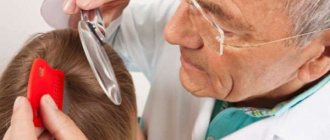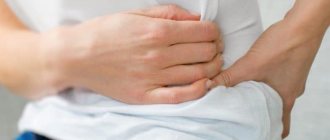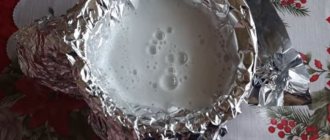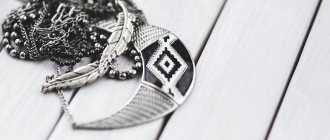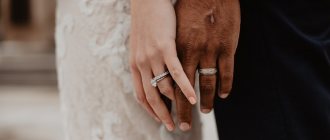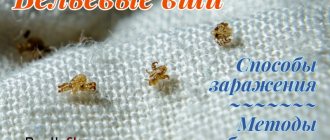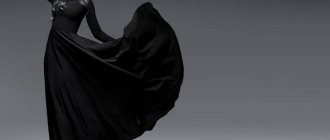If redness and an itchy rash are detected on the skin, it is necessary to exclude linen lice bites. Small blood-sucking parasites are easily carried on clothing and are well camouflaged in underwear and bedding. The problem can be encountered after visiting a hotel, a hospital ward, or a holiday in a children's camp. Therefore, it is recommended to know the symptoms and treatment features, and remember the rules of prevention at home.
Symptoms of linen lice
The presence of parasites can only be determined by bites on the body. Insects feed on blood and eat in most cases at night, when a person is in bed. The process of food absorption lasts up to 3 minutes, the frequency of bites is several times a week. Linen lice, unlike head lice, do not live on the body; they crawl there only to feed. If there is no food source for 7 days, the insects die.
The parasite injects a special substance that prevents blood clotting. With frequent bites, an allergic reaction and inflammation develop. When scratching, an infection gets into the wound and ulcers appear. Therefore, the symptoms of linen lice on the skin depend on the stage of infection and the number of parasites.
Insects settle in linen, mattresses, and underwear. In places where the power source is closest. Externally they resemble a head louse. The body size of an adult is up to 5 mm, the body is translucent. Elastic chitinous cover, capable of stretching. Nits are white, oblong in shape, up to 2 mm. Lice lay eggs in linen, bedding, and folds of clothing.
Do nits bite?
This question can be classified as: does a chicken egg eat grain? However, some firmly believe that lice eggs are the cause of red spots covering the skin. Believe me, this is an unfounded misconception.
A nit is a louse embryo with an undeveloped proboscis, enclosed in a durable, streamlined chain mail shell. Attached to the hair with the help of a special secretion, the nit is opened only when the time of maturation of the larva comes to an end. But in this case, it is no longer an empty shell that bites, but a completely independent louse.
Linen lice bites on the body, photo
Single bites are no different from a midge, mosquito, or bed bug. At the site of saliva injection, slight swelling and redness appear, and itching appears over time. There is a dark spot of dried blood in the center.
Currently reading: Nervous lice - can they appear?
With severe infection, there are many spots, they are located chaotically, often merge into one huge spot or look like a rash. Insects bite in areas where blood vessels are located closer to the surface - legs, shoulders, back, arms, neck. Less often the stomach. Adults are not bitten on the head; in children, bites are found on the face. Parasites do not live in the scalp.
How to avoid infection?
Preventing body lice from occurring won't be difficult if you know how it spreads and what needs to be done to prevent it from happening. For example:
- Lice can spread to another person as a result of close contact, and for quite a long time. Lice are capable of moving at a speed of 20 cm per minute, so quick contact does not threaten infection, since the parasite will not have time to move to another victim.
- Infestation with body lice can occur in crowded places. For example, this could be public transport, when people come into contact with each other for a long time and this time is enough for lice to move to another person.
- Preschool institutions and schools, especially junior grades, are also not an exception. As a rule, children are in contact with each other, regardless of the appearance of children or classmates.
- Such breeding grounds include spontaneous markets (flea markets), where used clothing is offered. Such clothing must be treated appropriately immediately.
If you know how these parasites spread, you can protect yourself from them by staying away from groups of people. Of course, in some cases it is simply impossible to do this, for example, during rush hour, but then you need to inspect your clothes upon arrival home. When entering an apartment, it is better to shake it off on the landing.
What body lice bites look like on the body, photo
Lice that live in things, bedding, and clothing have several names - linen lice, body lice, clothing lice, clothing lice. Nests are formed by insects in folds of fabric, blankets, mattresses, and underwear, but there is no difference between these parasites.
The symptoms are similar. Infection can occur at any time of the year, therefore, if itchy spots or swellings are detected, it is necessary to examine the head and bed.
Where can you catch the infection?
In order to avoid becoming a victim of dangerous parasites, it is important to understand what methods of infection there may be. The constant carrier of lice is a person with lice to one degree or another.
So, let's look at the main migration routes of lice:
- Contact. In case of close contact with a person with head lice, the lice simply climb onto a new victim, occupying the scalp or items of clothing. It's enough to just lie on one pillow or hug.
- Through care items. It is enough to use a sick person’s towel at least once to feel all the “beauty” of lice. Also at risk: combs, hairpins, washcloths, underwear, scarves, hats, pillows and other bedding. The lion's share of infections occurs on trains and in kindergartens and educational institutions.
- In second-hand or consignment stores. At favorable temperatures, parasites can remain on the clothes of the old “host” and wait for a new victim for several days.
- In a pond or swimming pool. Lice love humidity and live in water for up to 48 hours.
- Sexual path. During intimacy, pubic lice happily change hosts.
Linen bug bites, photo
Insects do not live in the wild; they live only in human habitation. Infection can occur at any time of the year. They get into the house with infected things or from neighbors through cracks in the wall, floor, sockets, wiring, ventilation shafts. They differ in appearance from linen fleas, but their lifestyle is similar.
Bedbugs settle closer to the sleeping area, but do not necessarily settle in the bed. These can be sockets, books, interior items, wallpaper, household appliances, and much more. They crawl out of their shelters at night and attack a sleeping person. Bites appear on the neck, shoulders, arms, back, legs. They often bite in open areas.
Adults feed once every 10 days, nymphs of different ages feed every 3 days. During the bite, a substance is injected that prevents blood clotting. Adult bedbugs contain pain-relieving components in their saliva, so people do not hear the bite itself. Symptoms appear in the morning.
Bed bugs pierce the skin in a certain sequence - 2 bites in the form of a path. There is inflammation, swelling, redness, and dried blood in the center. With severe infection, large spots and allergies form.
Body louse - structure, life cycle, reproduction, nutrition, habitat
Body lice have been parasitic for 70,000 years, they are dangerous insects, they carry various diseases - typhus, fever and others.
Life cycle – 16 days. An adult female can lay up to 10 eggs per day, that is, about 300 in her entire life. The life expectancy of the parasite is 1.5 months.
- larvae are laid;
- hatching process;
- after the first molt a nymph is formed;
- the nymph molts two more times;
- the larva becomes an adult.
Lice reproduce sexually.
Video: body lice (lice)
Linen flea bites
Small jumping creatures do not live in linen or clothes. They prefer to live under the floor, baseboards, in carpets, near the pet's sleeping place. The flea is dark, almost black in color, jumps well, and bites painfully. It begins to attack in the evening. Bites exposed areas of the body. Often the legs suffer. You can feel the bite immediately, since there is no anesthetic component in the saliva of insects. Redness, a dark spot with dried blood, and severe itching immediately appear. Swelling occurs with multiple bites. They parasitize mainly in the warm season; there are no fleas in winter. They don’t sneak into a sleeping person’s bed.
Currently reading: Incubation period of lice and nits - when to expect replenishment
Danger and possible consequences of infection
Body lice are dangerous due to the following consequences:
- Night sleep disorder.
- Decreased concentration.
- Anxiety.
- Violation of the integrity of the skin and the appearance of purulent wounds on them.
- Skin roughening - the insect injects a substance under the skin that reduces blood clotting. If the bite occurs several times in the same place, excessive accumulation of melanin occurs. The area of skin becomes rougher, changes color, and begins to peel off.
- Allergy to saliva and other insect waste products.
- Folliculitis, eczema - the result of scratching bites.
Lice are carriers of Volyn fever, tularemia, and typhus. Of course, nowadays these diseases are very rare, but they still should not be excluded.
Important! Diseases such as AIDS and viral hepatitis cannot be tolerated by lice.
Destruction of linen lice
Requires general cleaning and mass washing.
- The clothes that the person wore for a month before the bites appeared and if they are present are thrown into the wash, and the bedding is boiled. They wash things at 90 degrees Celsius. Dry outside, iron with steam.
- A person needs to take a shower and choose a means to treat bites. Single spots go away on their own within a week; massive bites require therapy.
- It is recommended to dry clean the mattress or treat it with an insecticidal agent, and after 2 hours take it out into the fresh air for ventilation.
- The house should be disinfested or thoroughly cleaned using special solutions to repel parasites. Linen lice do not live in carpets and soft toys.
If no bites appear on the body within 2 weeks, the operation to destroy parasites can be considered successful. If at least one bite occurs, washing the linen and bedding must be repeated.
Pubic lice
This type of lice lives in the genital area. Usually the female clings to the hairs on the pubis, after which it moves further and attaches to the pubis, merging in color with the skin. In the future, if there is no treatment, these parasites first occupy the genitals and anal area, after which they move to the armpits. This is the only type of lice that does not take root on the head.
The bites appear as bluish spots that do not disappear with pressure.
IMPORTANT: These parasites are most often found in men. This may be due to sexual contact with already infected commercial sex workers and poor genital hygiene. Although, infection is also possible when using someone else's clothes and even in a bathhouse.
Treatment at home is quite simple - you need to shave all the hair in the affected areas, and then use sulfur-mercury ointment or xylene. There are many remedies, including drugs that make the blood poisonous for these parasites.
Lice spray
There are no special means. Insecticidal aerosols and broad-spectrum sprays are used. Disinsection is carried out throughout the house if the room is heavily infested, or the bed, sofa on which the person slept, or mattress are treated.
The treatment procedure is simple - spray the poison at a distance of 20 cm from the surface and leave for 2 hours. The furniture is wiped with a solution of baking soda and salt to completely neutralize the effect of the insecticide. The mattress should be well aired.
If disinfestation is carried out throughout the apartment, leave the room closed for 2 hours, then carry out general cleaning and ventilate well. To combat linen lice, it is not necessary to use powerful insecticides; you can use any insect repellent aerosol with a wide spectrum of action:
- Raptor;
- Raid;
- Clean house;
- Dichlorvos;
- Karbofos.
You should work in a respirator and rubber gloves. If the product is used incorrectly, poisoning of varying degrees of severity occurs.
Currently reading: Lice on hair (photo) – in dreams and in reality
Prevention of body lice
The best method of preventing body lice is regular body hygiene, as well as timely washing of clothes and bed linen and subsequent heat treatment - ironing.
To avoid becoming infected with body lice, you must refrain from visiting the habitats of homeless people, do not use other people’s things, and also thoroughly wash items purchased at second-hand stores or spontaneous markets.
For many people, lice is a bolt from the blue; identifying the symptoms of lice literally comes as a shock. But there is nothing terrible or fatal about pediculosis, of course, if you deal with it in a timely manner. Treating your home, clothing, and using pediculicides will help quickly solve this problem.
Treatment of bites
At the initial stage of infection with pediculosis, you can use folk remedies, pharmaceutical drugs with antipruritic, anti-inflammatory properties. If an allergic reaction develops, antihistamine ointments and lotions are used. If the wounds become infected and ulcers form, local antibiotics are used.
Folk remedies for linen lice bites:
First aid supplies:
Antihistamines, antiallergic drugs:
Local antibiotics:
If the condition does not return to normal within 3 days, you should seek help from specialists.
How to relieve itching
Remedies for relieving itching from lice bites
A lice bite causes pain and discomfort. Unpleasant sensations may persist even after the insects have been killed. It is not uncommon for the head to continue to itch after lice are removed. But there are remedies that help alleviate the patient’s condition and relieve pain:
- The wounds should be washed with warm water and soap. You can take baby or tar soap. It should not cause allergies, otherwise the itching will only get worse.
- Treat the comb with vodka or alcohol. It will kill pathogenic bacteria and relieve discomfort.
- Lubricate the inflamed wound with Rescuer ointment. It will speed up the healing of the abscess.
- Severe itching will be relieved by Zvezdochka or Fenistil balm.
- Menovazine is used if an allergy appears from lice bites. In this case, you can take an antihistamine: Zodak, Lorotadin, Suprastin. You should drink it following the instructions.
Sometimes insect bites cause nausea, headaches, and swollen lymph nodes. In this case, you should immediately consult a doctor. The doctor will determine whether a serious illness has occurred or whether a severe allergic reaction has occurred.
To cure lice, it is not enough to just treat the bite sites. It is necessary to get rid of lice. To do this, you should buy a special product at the pharmacy. During the treatment period, it is necessary to change bed linen and clothes every day. In addition to these measures, sanitizing the apartment is recommended.
Fighting methods
There are quite a lot of tips on how to get rid of uninvited guests. Below are tips that will help you get rid of bed lice once and for all.
- If you suspect the presence of bed lice, you should take the hottest possible shower. The body should be thoroughly washed with laundry soap with a high alkali content.
- The surest remedy for such lice is thorough disinfection of all bedding. Linen and other wardrobe items that are in doubt should be soaked in a 20% solution of kerosene and soap. Things should be soaked for about forty minutes.
- Freshly squeezed cranberry juice will help in the fight against linen lice nits. It is recommended to use the juice to treat areas of the body where itching appears.
- All items intended for personal use, such as hairpins, hair ties, and combs, should be thoroughly boiled. After boiling, they should be placed in the sun and left for two to three days.
- An excellent way to scare away unwanted guests from your bed is ordinary dried tansy, which can be purchased at any pharmacy. All you need to do is just spread the leaves on the bed.
- Another way to get rid of linen lice is aromatic oils and tar soap. Lice are especially susceptible to lavender oil and tea tree oil.
Finally, it should be said that time plays an extremely important role in the fight against these invisible parasites. If at least one individual is detected, the entire home and clothing should be disinfected. If you delay just a few days, the lice will become noticeably more numerous and getting rid of them will be much more difficult.
Be careful and attentive to your health - choose the doctor that suits you and make an appointment by phone: 8 (499) 969-20-36 (for residents of Moscow and the Moscow region).
